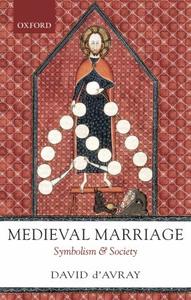Medieval Marriage. Symbolism & Society
CODICE: ISBN 0199239789 EAN 9780199239788
AUTORE/CURATORE/ARTISTA :
Author: David D'Avray
EDITORE/PRODUTTORE : Oxford University Press
COLLANA/SERIE : -
DISPONIBILITA': Disponibile
TITOLO/DENOMINAZIONE:
Medieval Marriage. Symbolism & Society
PREZZO : EUR 45,09€
CODICE :
ISBN 0199239789
EAN 9780199239788
AUTORE/CURATORE/ARTISTA :
Author: David D'Avray
EDITORE/PRODUTTORE:
Oxford University Press
COLLANA/SERIE:
ANNO:
2007
DISPONIBILITA':
Disponibile
CARATTERISTICHE TECNICHE:
336 pages
Paperback
cm 13,8 x 21,6
DESCRIZIONE:
Publisher's description:
- Deals with the nature of the western marriage tradition at a formative period
- Examines the medieval period in the whole of Europe, using a wide range of sources
- Expands the source base for the history of medieval marriage
This study shows how marriage symbolism emerged from the world of texts to become a social force affecting ordinary people. It covers the whole medieval period but identifies the decades around 1200 as decisive. New arguments for regarding preaching as a mass medium from the thirteenth century are presented, building on the author's Medieval Marriage Sermons. In marriage preaching symbolism was central. Marriage symbolism also became a social force through law, and lay behind the combination of monogamy and indissolubility which made the medieval Church's marriage system a unique development in world history. Symbolism is not presented as an explanation on its own: it interacted with other causal factors, notably the eleventh-century Gregorian Reform's drive for celibacy, which made the higher clergy like a third gender and less sympathetic to patriarchal polygamous tendencies. Sexual intercourse as a symbol of Christ's union with the Church became central, not just in mysticism but in society as structured by Church law. Symbolism also explains apparently bizarre rules, such as the exemption from capital punishment of clerics in minor orders provided that they married a virgin not a widow. The rules about blessing second marriages are also connected with this nexus of thought.
The book is based on a wide range of manuscript sources: sermons, canon law commentaries, Apostolic Penitentiary registers, papal bulls, a gaol delivery roll, and pastoral handbooks. The collection of documents at the end of the book expands the source base for the history of medieval marriage generally as well as underpinning the thesis about symbolism.
GENERE: Libri ,Saggi ,



